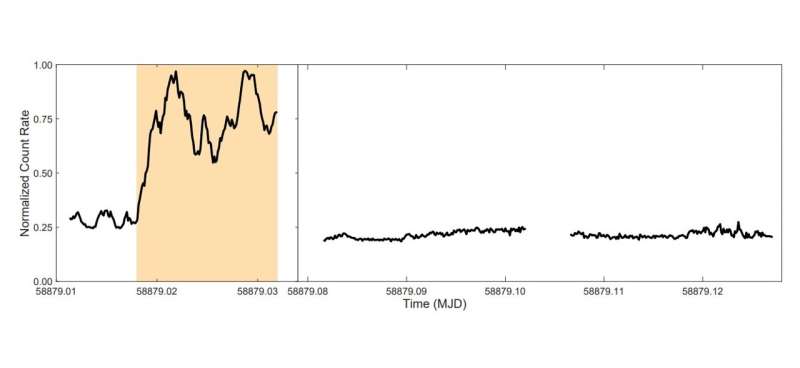December 2, 2022 report
Study investigates pulsations of the millisecond pulsar PSR J1023+0038

European astronomers have conducted X-ray and optical observations of a transitional millisecond pulsar known as PSR J1023+0038. Results of the observational campaign, published November 23 on arXiv.org, yield important insights on the origins of pulsations of this source.
Pulsars are highly magnetized, rotating neutron stars emitting a beam of electromagnetic radiation. The most rapidly rotating pulsars, with rotation periods below 30 milliseconds, are known as millisecond pulsars (MSPs). Astronomers assume that they are formed in binary systems when the initially more massive component turns into a neutron star that is then spun up due to accretion of matter from the secondary star.
Some millisecond pulsars switch between low-mass X-ray binary (LMXB) and a radio millisecond pulsar (RMSP) states. These sources were dubbed transitional millisecond pulsars (tMSPs). Observations show that tMSPs are in general rapidly rotating, weakly magnetized neutron stars that swing between the two states within a few days. Such behavior may be powered by different physical mechanisms.
Located some 4,000 light years away from the Earth, PSR J1023+0038 is only one of the three tMSPs so far detected. It has a spin period of approximately 1.688 milliseconds and its orbital period is estimated to be 0.198 days. PSR J1023+0038 is the first MSP that was ever observed as an optical pulsar.
PSR J1023+0038 showcases optical and X-ray pulsations that were first detected simultaneously in the X-ray high modes, but they disappeared when the source transited in the low modes, which suggests a common emission mechanism. To date, this pulsar remains the only tMSP with detectable pulsed emission in the optical band.
In order to better understand the emission mechanism behind the optical and X-ray pulsations of PSR J1023+0038, a team of astronomers led by Giulia Illiano of the Astronomical Observatory of Rome in Italy, decided to study the phase lag between the pulses in the optical and X-ray bands, hoping to shed more light on the physical mechanisms that cause it.
"We performed a detailed timing analysis of simultaneous or quasi-simultaneous observations in the X-ray band, acquired with the XMM-Newton and NICER satellites, and in the optical band, with the fast photometers SiFAP2 (mounted at the 3.6 m Telescopio Nazionale Galileo) and Aqueye+ (mounted at the 1.8 m Copernicus Telescope)," the researchers wrote in the paper.
The study found that optical pulses of PSR J1023+0038 have total rms pulsed amplitudes of about 0.1–0.8%, while the X-ray total rms pulsed amplitudes are in the range 4.3–10.8%. It turned out that optical pulses lag the X-ray pulses by approximately 150 microseconds.
The results show that the phase lag between optical and X-ray pulsations lies in a limited range of values (0–250 microseconds) over timescales of about five years. This finding suggests that both pulsations originate from the same region and that their emission mechanisms are linked.
The astronomers assume that the shock-driven mini pulsar nebula scenario is the most plausible hypothesis that could explain the origin of the optical and X-ray pulsations of PSR J1023+0038. This scenario suggests that the pulses are generated by synchrotron radiation emitted from a shock formed where the striped pulsar wind meets the accretion disk, within about 100 km from the pulsar.
More information: G. Illiano et al, Investigating the origin of optical and X-ray pulsations of the transitional millisecond pulsar PSR J1023+0038, arXiv (2022). DOI: 10.48550/arxiv.2211.12975
Journal information: arXiv
© 2022 Science X Network





















